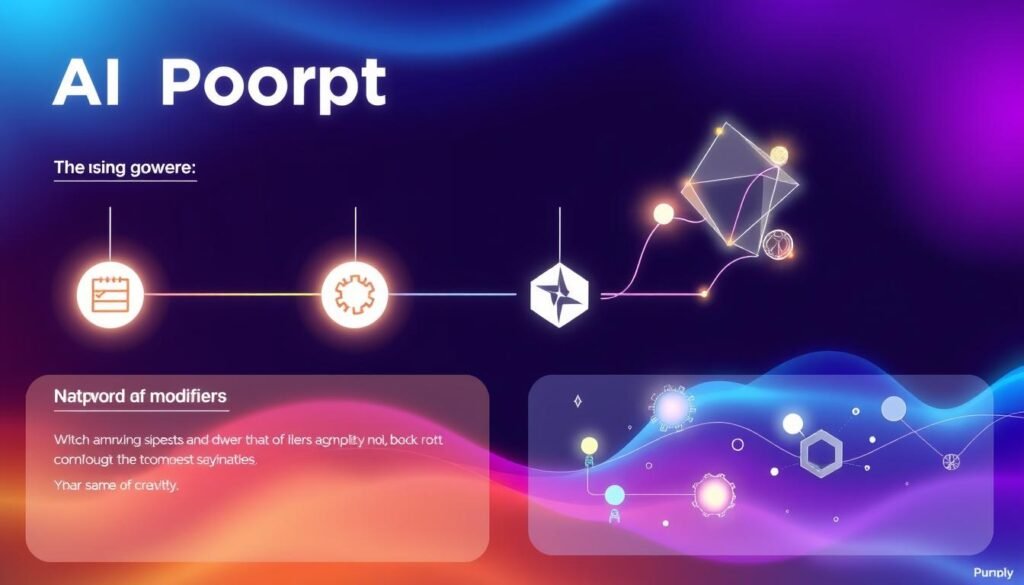Did you know only 10% of AI guides are for advanced users? Most focus on beginners and those in between1. If you want to get the most out of language models like GPT1, it’s time to learn AI prompting. This guide will show you how to write prompts that get you the results you need, whether you’re writing, marketing, or studying.
AI prompting is about giving clear instructions to language models. This helps them create what you need, like text summaries or answers to questions1. Learning this skill will make your AI interactions better and help you get great results in many fields.
Key Takeaways
- Discover the power of AI prompting to unlock the full potential of language models
- Learn how to define your persona and clearly articulate your task for the AI model
- Explore strategies to structure your prompts for effective text summarization, information extraction, and question answering
- Gain insights from real-life case studies across various industries
- Measure the ROI of your AI solutions through key metrics like cost efficiency and productivity gains
What is AI Prompting?
AI prompting is about making clear instructions for language models. These instructions help them create things like text summaries, information extraction, and question answering. Learning to do this well lets users get the most out of AI systems2.
Good AI prompts act like a map. They give language models the context and details they need. This way, the AI can give answers that meet the user’s needs2.
Crafting Effective AI Prompts
To make great AI prompts, you need to focus on a few things. These include:
- Clear instructions and specific details
- Relevant background information and context
- A logical, easy-to-follow structure
- Simple, conversational language
- Examples to show what you want
- A prompt that is error-free and to the point
By paying attention to these points, you can make prompts that help language models do their job. This could be summarizing documents, extracting important info, or answering tough questions2.
“Crafting well-structured prompts for desired outputs is key to unlocking AI’s full power.”
– Darrell Lerner, AI Prompt Engineer2
As AI prompting gets better, knowing how to talk to these systems will matter more. By getting good at making prompts, users can make their work easier. They can also do more with language models in many areas3.
The Importance of Effective AI Prompts
Making effective AI prompts is key to getting the best from generative AI tools. Learning prompt engineering helps users get better results. This is true for tasks like text summarization and answering questions4. The guide says specific prompts are better than general ones for quality AI outputs4.
Being clear and concise in prompts leads to better results4.
Understanding natural language processing and AI literacy is vital for effective AI prompts. Quality prompts are concise, logical, and explicit. This ensures coherent and useful outputs from language models5. Clear and detailed instructions in prompts improve AI output quality5.
- The guide suggests that asking AI to behave as if it were a certain person, process, or object can lead to better prompts and tailored responses4.
- Generative AI tools can produce various types of outputs such as code, stories, reports, dialogues, and images, among others4.
- Instructing AI on what to include and exclude in responses can save time and enhance results4.
Mastering effective AI prompting unlocks the full power of these tools. Tailoring prompts to specific audiences makes AI content more relevant. Including what not to do in prompts improves output specificity5.
“Effective AI prompting is the key to unlocking the full power of generative AI tools.”

Whether you’re a writer, marketer, or student, learning effective ai prompts boosts your AI use. Prompt chaining generates continuous, connected ideas. Keeping prompts clear and concise ensures focused AI output5.
| Prompt Engineering Techniques | Benefits |
|---|---|
| Adding background context and examples to prompts | Enhances the relevance of AI results5 |
| Understanding the specific process of each AI tool | Improves prompt effectiveness5 |
| Providing examples to help AI emulate desired tone and style | Leads to better AI-generated content5 |
Mastering prompt engineering improves AI interactions, leading to better outcomes4. AI prompts may benefit from examples to improve outputs without copyright issues. Specifics about the audience and desired tone enhance AI content4.
The key to effective AI prompting is understanding AI’s capabilities and limitations. Refining and improving prompts is essential4. Building on previous prompts and correcting mistakes refines AI outputs. Asking AI to create prompts or specify needed information leads to better results4.
Defining Your Persona and Task
Creating effective persona-based prompts starts with knowing who you are and what you need. By telling the AI model your role, like writer, marketer, or student, it can give you what you need6.
Also, saying what you want, like a summary or answers to questions, helps the AI know what to do7.
Persona and Task Articulation
When prompt tailoring, remember a few things:
- Know your role (e.g., writer, marketer, student) to get the right answers7.
- Tell the AI what you need, like a summary or answers7.
- Give context so the AI can understand better8.
| Persona | Task |
|---|---|
| Writer | Generate a 250-word summary of the key points in a 10-page research paper on the impact of climate change on agricultural production. |
| Marketer | Provide a detailed competitive analysis of the top 3 products in the home fitness equipment market, including features, pricing, and target audience. |
| Student | Answer the following question: “What were the main causes of the American Civil War, and how did they contribute to the conflict?” |

By knowing who you are and what you need, you can make persona-based prompts. This helps the AI give you better, more useful answers67.
“Effective prompt engineering is a key skill for working with AI. It ensures you get the right and useful information.”
Structuring Your Prompt
Making a good prompt is key to getting what you want from an AI. Prompt structure, format, components, and best practices are important when using AI9.
First, decide what kind of response you need, like an email or a script. Give the AI all the context it needs to understand the task. If it helps, share examples for the AI to look at. Also, tell the AI where to find the facts it needs10.
- Use a clear format, like the ABC method (Action, Background, Context), to help the AI9.
- Change your prompt style based on the task, whether it’s writing, data analysis, or searching9.
- Keep tweaking your prompts to get better results from the AI10.
Learning how to structure prompts well can make AI work better for you910.

“Effective prompt engineering is the key to unlocking the true capabilities of AI systems.”
Good prompts are the start of great AI interactions. Learning about prompt structure, formatting, and best practices will help you use AI confidently910.
how to learn ai prompting
Learning AI prompting is key in today’s fast-changing digital world. It means writing clear instructions for AI to create what you need, like text summaries or answers to questions. Whether you write, market, or study, knowing AI prompting can open new doors and make you more productive11.
To begin learning AI prompting, look for special courses or talk to AI experts. The Google Prompting Essentials course is a great place to start. It has 9 video lessons and 7 code examples for beginners12.
- Learn the basics of AI prompting, like text-to-text and text-to-image.
- Practice making prompts with a 5-step plan for clarity and results.
- Keep a collection of prompts you can use and improve over time.
- Try out different AI prompting methods, like few-shot prompting, to get the most from AI.
- Keep up with new AI prompting tools and techniques to improve your skills.
Getting good at AI prompting takes time and effort. Keep practicing, trying new things, and learning. This way, you’ll get better at telling AI what to do and discover new possibilities3.

“AI prompting is not just a skill, it’s a superpower. Unlock your full power and change how you use technology.”
Text Summarization Prompts
AI text summarization is great for quickly getting the main points from long documents or reports13. By making specific prompts, you can get to the heart of the matter without getting lost in details13. This is super helpful for people who are short on time, like busy executives or students.
Craft Precise Prompts for Effective Summaries
To make good prompts, you need to be clear and specific13. Tell the AI what you want it to do, like summarize a technical report13. You can also tell it who you’re writing for, which helps shape the tone and technical level of the summary13.
| Prompt Example | Summary Output |
|---|---|
| Summarize the key points of the research report on renewable energy trends in a concise, easy-to-understand way for a general audience. | The research report highlights the growing shift towards renewable energy sources, with solar energy expected to take the lead in the next decade14. Business leaders anticipate significant growth in wind and solar power, as well as a decline in the use of fossil fuels14. The report also notes that renewable energy sources are expected to make up 25% or more of the global energy production mix by 205014. |
Clear prompts help AI models create summaries that get straight to the point13. This makes it easier for your audience to grasp the important info quickly13.
Information Extraction Prompts
Information extraction turns unstructured text into structured data. This process helps us find and use important information from various texts15. It’s useful for analyzing customer feedback, medical records, and more, helping us make better decisions15.
Creating good prompts for AI models takes time and effort. They help us get the right data from texts15. For example, in business, prompts can summarize long reports quickly, giving us key insights for fast decisions15.
Prompts can also help find trends in customer feedback. This way, businesses can see what needs improvement15.
Researchers use prompts to find information in papers fast. This makes research easier15. Text classification prompts help sort content, like news, into categories15.
Conversation AI prompts make chatbots and virtual assistants more natural. They improve how we interact with technology15. They also help generate code from text, making database queries easier15.
Improving prompts involves several techniques. These include few-shot prompting and Chain of Thought Reasoning16. The goal is to make prompts better with each try16.
While making prompts is complex, it leads to better data use. This is true across many industries15. By getting good at prompts, we can make AI work better for us15.
| Prompt Template Sections | Description |
|---|---|
| Summary of Task | A concise overview of the information extraction objective |
| Extraction Criteria | Specific details on the type of information to be extracted |
| Examples | Sample inputs and expected outputs to illustrate the task |
| Exclusion Criteria / Negative Examples | Conditions or examples that should not be extracted |
| Output Instructions | Formatting guidelines for the extracted information |
Creating prompt templates is key to better information extraction. It helps overcome challenges and follow best practices16.
Question Answering Prompts
Question Answering (QA) systems use natural language processing to give clear answers to questions. They help you find information quickly from big datasets like research papers or customer service guides. This makes tasks like research, customer support, and learning easier.
Creating good prompts is key to getting the most from QA systems. Your prompts should be clear, logical, and direct. This helps the AI give you the best answers. The CLEAR framework by Leo Lo shows what makes a great prompt: Clear, Logical, Explicit, Adaptive, and Reflective.
- Clear: Your prompts should be short and easy to understand17.
- Logical: The prompt should make sense, with a clear order of ideas17.
- Explicit: Give the AI all the details it needs, so it doesn’t guess17.
- Adaptive: Be ready to change your prompts based on the AI’s answers17.
- Reflective: Check if the AI’s answers are right, relevant, and complete. Use this to make your prompts better17.
By using the CLEAR framework, you can make prompts that help the AI give you what you need. This is useful for research, customer support, or any task that needs a lot of knowledge17.
Getting better at QA prompts takes practice and patience. Keep working on your prompts until they give you the results you want18. With time and effort, you’ll get really good at using AI for answering questions1817.
Conclusion
Learning to master ai prompting mastery is key in today’s fast-changing AI world. By creating great prompts, you can make the most out of language models. This improves your human-ai collaboration in many generative ai applications.
From summarizing texts to answering questions, the tips in this article will help you. They will make your work more efficient and keep you up-to-date with AI trends19.
If you’re a writer, marketer, or student, these strategies will boost your confidence in AI prompting. By knowing your audience and structuring your prompts well, you can get better results from AI tools20.
Keep practicing your ai prompting mastery skills. The more you use AI tools, the better your results will be. With these tips and resources, you’re ready to excel in human-AI collaboration and make our future interactions with AI smooth and productive20.
FAQ
What is AI prompting?
Why is effective AI prompting important?
How do I define my persona and task for AI prompting?
What are the key components of structuring an effective AI prompt?
How can I improve my AI prompting skills?
How can AI prompting be used for text summarization?
How can AI prompting be used for information extraction?
How can AI prompting be used for question answering?
Source Links
- The Art of AI Prompt Crafting: A Comprehensive Guide for Enthusiasts – https://community.openai.com/t/the-art-of-ai-prompt-crafting-a-comprehensive-guide-for-enthusiasts/495144
- How to Write Good AI Prompts: A Beginner’s Guide (+12 Ready-Made Templates) – https://www.getmagical.com/blog/how-to-write-good-ai-prompts
- Learn AI Prompting with Google Prompting Essentials – https://grow.google/prompting-essentials/
- Getting started with prompts for text-based Generative AI tools – https://huit.harvard.edu/news/ai-prompts
- Best practices for generating AI prompts – Work Life by Atlassian – https://www.atlassian.com/blog/announcements/best-practices-for-generating-ai-prompts
- Strategies for AI Success: Master the Art of AI Prompting in 2024 – https://www.linkedin.com/pulse/strategies-ai-success-master-art-prompting-2024-cut-the-saas-com-m4otf
- Mastering Prompt Engineering: One of The Keys to AI Success – https://go-planet.com/perspectives-blog/mastering-prompt-engineering-one-of-the-keys-to-ai-success/
- Promptcraft Mastery P1: Best AI Prompting & Prompt Crafting Techniques – https://medium.com/@alozie_igbokwe/mastering-the-art-of-ai-prompting-p1-from-basics-to-advanced-techniques-a73d298ff857
- Prompt Like a Pro: A Beginner’s Guide to AI Prompting – https://www.linkedin.com/pulse/prompt-like-pro-beginners-guide-ai-prompting-victoria-s-
- The ultimate guide to writing effective AI prompts – Work Life by Atlassian – https://www.atlassian.com/blog/announcements/ultimate-guide-writing-ai-prompts
- Learn how to write AI prompts in 5 easy steps with this new course from Google – https://blog.google/outreach-initiatives/grow-with-google/learn-how-to-write-ai-prompts-in-5-easy-steps-with-this-new-course-from-google/
- ChatGPT Prompt Engineering for Developers – DeepLearning.AI – https://www.deeplearning.ai/short-courses/chatgpt-prompt-engineering-for-developers/
- Basic Prompting – https://github.com/dair-ai/Prompt-Engineering-Guide/blob/main/guides/prompts-basic-usage.md
- The common art of prompt engineering – https://medium.com/@glincy/the-common-art-of-prompt-engineering-d610f85e4af3
- The Art of the Prompt: Mastering AI to Enhance Data Interaction – https://medium.com/@thomasczerny/the-art-of-the-prompt-mastering-ai-to-enhance-data-interaction-99365f1a213a
- Simplify Information Extraction: A Reusable Prompt Template for GPT Models – https://towardsdatascience.com/simplify-information-extraction-a-reusable-prompt-template-for-gpt-models-d6d5f1bd25a0
- Guides: Artificial Intelligence (Generative) Resources: How to Craft Prompts – https://guides.library.georgetown.edu/ai/prompts
- AI 101 – a short guide to good prompts – https://davethesmith.wordpress.com/2023/07/04/ai-101-a-short-guide-to-good-prompts/
- Research Guides: AI-Based Literature Review Tools: How to Craft Prompts – https://tamu.libguides.com/c.php?g=1289555&p=9642751
- Making AI Work for You: The Prompt Secrets to Better Results – https://www.convirza.com/content-hub/ai-prompting-secrets-guide/
